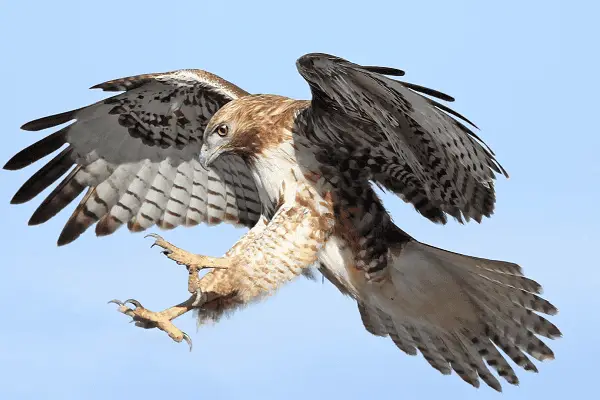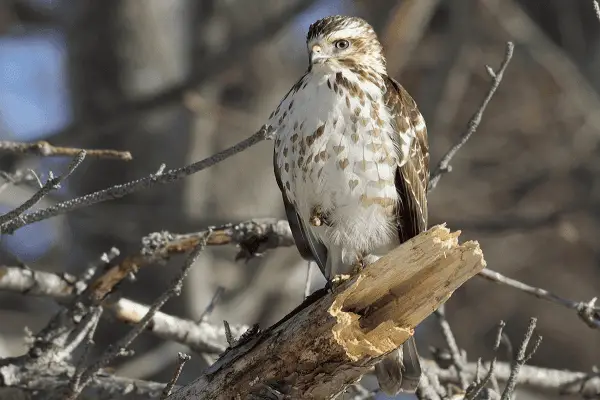Have you ever wondered about the magnificent hawks that grace the Tennessee skies? From their impressive wingspans to their hunting prowess, these birds of prey never fail to capture our attention. But did you know that Tennessee is home to not just one or two, but eight different types of hawks? Yes, you read that right! There’s a multitude of hawk species soaring above the Volunteer State, each with its unique characteristics and beauty.
In this article, we will take you on a fascinating journey into the world of hawks in Tennessee. You’ll get to know these incredible predators up close and personal, complete with stunning pictures that showcase their distinctive features. So, are you ready to explore the diverse species of hawks that call Tennessee home?
Here are the main points:
- Discover the eight different types of hawks found in Tennessee.
- Learn about their unique characteristics and hunting strategies.
- Get up close with stunning pictures of these majestic birds.
- Understand the important role hawks play in the ecosystem of the Volunteer State.
- Keep an eye out for these magnificent creatures soaring through the Tennessee skies.
Red-shouldered Hawk
The Red-shouldered Hawk is a medium-sized hawk species found in Tennessee. With its distinctive red shoulder patches, this hawk is a striking sight in the Tennessee skies. Its vibrant coloring is a source of fascination for bird enthusiasts and photographers alike.

This hawk is known for its adaptability and can be found in a variety of habitats, including wooded areas, wetlands, and even suburban neighborhoods. Its preference for perching near wooded areas makes it a common sight for nature enthusiasts exploring Tennessee’s forests.
The Red-shouldered Hawk primarily feeds on small mammals such as voles and mice, using its keen eyesight to spot its prey from above. It is also known to consume reptiles, amphibians, and occasionally small birds. This diverse diet allows the Red-shouldered Hawk to thrive in a range of environments.
Distinctive Features:
- Size: Medium-sized hawk
- Red shoulder patches
- Long wingspan
These features, combined with its striking red plumage, make the Red-shouldered Hawk easily recognizable among other hawk species.
Did you know? The Red-shouldered Hawk’s scientific name, Buteo lineatus, comes from the Latin word “lineatus,” meaning “striped.” This refers to the bird’s distinctive striped plumage.
Population Status:
The population of Red-shouldered Hawks in Tennessee is generally stable, thanks to conservation efforts and protected habitats. These hawks are a valuable part of the state’s ecosystem, playing a crucial role in maintaining balance among prey species.
| Conservation Status | Population Trend | Threats |
|---|---|---|
| Near Threatened | Stable | Habitat loss |
The Red-shouldered Hawk serves as a reminder of the importance of preserving Tennessee’s diverse habitats to ensure the continued survival of its unique bird species.
So next time you’re out exploring Tennessee’s natural beauty, keep an eye out for the Red-shouldered Hawk and admire its vibrant colors and impressive hunting skills.
Northern Harrier

The Northern Harrier is another fascinating hawk species found in Tennessee. With its low, soaring flight and owl-like facial disk, this hawk is a master of hunting small birds and mammals in open fields and marshes.
Red-tailed Hawk

The Red-tailed hawks is one of the most commonly seen hawks in Tennessee. With its broad wings and characteristic red tail, this hawk is a formidable predator that preys on small mammals and birds of prey.
Cooper’s Hawk

The Cooper’s Hawk, a medium-sized hawk species, is commonly found in Tennessee.
This bird of prey is known for its agile flight and is often mistaken for the Sharp-shinned Hawk. However, the Cooper’s Hawk is larger and has a more rounded tail.
The Cooper’s Hawk is a formidable hunter that frequents bird feeders in Tennessee, preying on smaller birds. Its stealth and speed make it a skilled predator in the avian world.”
Fun fact: The Cooper’s Hawk is named after the American ornithologist William Cooper, who first described this species in the 19th century.
Cooper’s Hawk vs. Sharp-shinned Hawk
Though the Cooper’s Hawk and Sharp-shinned Hawk may resemble each other, there are some notable differences between the two:
| Characteristics | Cooper’s Hawk | Sharp-shinned Hawk |
|---|---|---|
| Size | Medium-sized | Small-sized |
| Tail Shape | Rounded | Square |
| Behavior | Predominantly seen near bird feeders | Often found in forested areas or near open spaces |
Both hawks are skilled hunters and play important roles in maintaining the balance of Tennessee’s ecosystem.
Sharp-shinned Hawk

The Sharp-shinned Hawk is the smallest hawk species found in Tennessee. With its dark brown plumage and rapid flight, this hawk is a skilled predator that preys on small birds, making it a frequent visitor to bird feeders.
Broad-winged Hawk
The Broad-winged Hawk is a bird of prey known for its distinctive call and migratory behavior. During the breeding season, these hawks can be seen nesting in Tennessee before embarking on their remarkable journey south for the winter.

Broad-winged Hawk, scientifically known as Buteo platypterus, is a medium-sized hawk species measuring about 13-17 inches in length with a wingspan of around 31-39 inches. This hawk species is easily recognizable with its broad wings and triangular shape when soaring through the sky.
Their call, often described as a high-pitched whistle, is a characteristic sound associated with the Broad-winged Hawk. This vocalization is often used during courtship displays and territorial defense.
One of the most impressive aspects of the Broad-winged Hawk is its migratory behavior. These hawks undertake one of the longest-known mass migrations of any North American raptor. In late summer or early fall, they gather in large flocks known as “kettles” and embark on an incredible journey to their wintering grounds in Central and South America. This spectacle is a popular event for bird enthusiasts and nature lovers throughout Tennessee.
During their nesting season in Tennessee, the Broad-winged Hawks build their nests in deciduous or mixed forests, constructing them with sticks and lining them with softer materials such as moss and leaves. These nests are often placed in the forks of trees, providing a secure place for their eggs and young.
The diet of the Broad-winged Hawk primarily consists of small mammals, reptiles, amphibians, and insects. They are skilled hunters, using their sharp talons to capture prey with precision.
If you want to witness the impressive migration of Broad-winged Hawks or simply observe their hunting behaviors, Tennessee provides an excellent opportunity. Keep your eyes peeled for these magnificent hawks soaring through the skies or listen for their distinctive call during the breeding season.
Northern Goshawk

The Northern Goshawk is a fascinating and powerful hawk species that can be found in Tennessee. With its impressive size, broad wingspan, and aggressive hunting behavior, the Northern Goshawk is a formidable predator that preys on small mammals and birds. This hawk’s ability to effortlessly navigate through the dense forests of Tennessee makes it a skilled and stealthy hunter.
“The Northern Goshawk is an apex predator, and its hunting techniques are truly remarkable. With its acute vision and lightning-fast flight, it can swiftly and silently strike its prey from above, capturing it with its sharp talons.”
The Northern Goshawk is known for its exceptional aerial agility, allowing it to maneuver effortlessly through the tree canopy in pursuit of prey. Its broad wings and long tail provide excellent control and maneuverability during flight, making it one of the most skilled predators in Tennessee.
If you’re lucky enough to spot a Northern Goshawk in Tennessee, you’ll be treated to a captivating display of its hunting prowess. Keep your eyes peeled for this magnificent hawk soaring through the skies, as it is truly a sight to behold!
Interesting Facts about the Northern Goshawk:
- The Northern Goshawk is the largest member of the accipiter genus, which includes other species of hawks such as the Sharp-shinned Hawk and Cooper’s Hawk.
- These hawks are known for their fierce territorial behavior, vigorously defending their nesting sites and hunting grounds.
- Female Northern Goshawks are significantly larger than males, with an average wingspan of around 3 feet.
A Comparison of Tennessee Hawks
| Hawk Species | Size | Wingspan | Prey |
|---|---|---|---|
| Red-shouldered Hawk | Medium-sized | Approximately 18-24 inches | Small mammals, reptiles, amphibians |
| Northern Harrier | Large-sized | Approximately 38-48 inches | Small birds, mammals |
| Red-tailed Hawk | Large-sized | Approximately 45-52 inches | Small mammals, birds of prey |
| Cooper’s Hawk | Medium-sized | Approximately 14-20 inches | Small birds |
| Sharp-shinned Hawk | Small-sized | Approximately 9-13 inches | Small birds |
| Broad-winged Hawk | Medium-sized | Approximately 32-39 inches | Small mammals, reptiles, birds |
| Northern Goshawk | Large-sized | Approximately 24-40 inches | Small mammals, birds |
| Rough-legged Hawk | Medium-sized | Approximately 48-56 inches | Small mammals |
Rough-legged Hawk
The Rough-legged Hawk is another impressive species found in Tennessee. Adapted to the colder climates, these hawks are well-suited for the winter season in the Volunteer State. With their broad wings and keen eyesight, they are skilled hunters who primarily feed on small mammals.

During the winter, the Rough-legged Hawks migrate to Tennessee from their breeding grounds in the northern regions. This makes them a common sight in the state during this time of year. You can often spot them soaring high above the open fields and marshlands, searching for their next meal.
One of the unique features of the Rough-legged Hawk is its feathered legs, which provide additional warmth during the colder months. This adaptation allows them to thrive in colder climates where other hawk species may struggle.
Distinctive Characteristics of the Rough-legged Hawk:
- Broad wings for efficient gliding and soaring
- Feathered legs for insulation
- Light and dark morph variations
- Keen eyesight for spotting prey from a distance
These hawks play an essential role in the ecosystem, helping to control populations of small mammals such as mice and voles. Their presence in Tennessee adds to the rich diversity of hawks in the state, showcasing the fascinating adaptability of these birds of prey.
Next, let’s take a closer look at the different species of hawks found in Tennessee and their unique characteristics.
| Hawk Species | Distinctive Features |
|---|---|
| Red-shouldered Hawk | Distinctive red shoulder patches |
| Northern Harrier | Owl-like facial disk and low, soaring flight |
| Red-tailed Hawk | Broad wings and characteristic red tail |
| Cooper’s Hawk | Medium-sized hawks are often seen near bird feeders |
| Sharp-shinned Hawk | Small hawk with dark brown plumage and rapid flight |
| Broad-winged Hawk | Distinctive call and migratory behavior |
| Northern Goshawk | Large, powerful hawk and aggressive hunter |
| Rough-legged Hawk | Broad wings and feathered legs for insulation |
Final Thoughts
Tennessee is home to a diverse population of hawks, making it a haven for bird enthusiasts and nature lovers alike. The species of hawks in Tennessee showcase a wide range of unique characteristics and hunting strategies, adding to the rich biodiversity of the Volunteer State.
From the small and agile Sharp-shinned Hawk to the majestic Red-tailed Hawk, these formidable birds of prey play a crucial role in maintaining the ecological balance. They are skilled hunters, preying on a variety of small mammals and birds, keeping populations in check and contributing to the health of their habitats.
If you find yourself in Tennessee, keep your eyes peeled for these magnificent creatures soaring through the skies. Whether you’re exploring wooded areas or open fields, you may have the privilege of witnessing the breathtaking flight and hunting prowess of hawks in Tennessee. So grab your binoculars and embark on an unforgettable birdwatching adventure in the Volunteer State!
